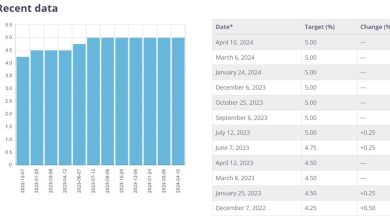Forexlive Americas FX News Conclusion May 3: US employment reports are weaker than expected this month.

US employment data for March was lower than expected, at 175,000 versus estimates of 243,000. The previous month was revised upward to 315K from 303K previously reported. The unemployment rate rose from 3.8% to 3.9%, while the average hourly wage stood at 3.9% year-over-year, the lowest level since 2021. The average work week increased also dropped to 34.3 from 34.4 last month.
Information jobs fell by -8,000. Professional and business services showed a decline for the month of -4,000. Other relatively weak sectors included government (+8,000), financial activities (+8,000). 6,000), leisure and hospitality (+5,000) and construction (+9,000).
Goods-producing jobs added just 14,000 jobs, while private service jobs added 153,000, thanks to an increase of 95,000 in education and health care.
The data only covers one month. The Fed chairman suggested after the Fed meeting that he would need to slow down the US labor market to convince the Fed that growth and inflation were likely to slow further. This week, the Fed chairman spoke a little less hawkishly than expected, saying a hike was not likely (at least for now). There were fears that the Fed would move towards a more symmetrical policy.
Today’s report allows for a sigh of relief, but will need to be followed by signs that inflation is easing and job growth is indeed fading.
Later in the day, the ISM non-manufacturing prices paid component did not help as it rose to 59.2 from 53.4 last month. The CPI and PPI report later this month will be important again.
Separately, the muzzle on other Fed officials was removed today along with Fed Governor Bowman and Chicago Fed President. Goolsbee spoke after the US jobs report.
Federal Reserve Governor Michelle Bowman (rather hawk) has lamented the complexity of managing inflation and interest rates amid varying economic indicators. She stressed that while inflation is expected to decline with current interest rates, the Federal Reserve remains open to further rate increases if inflation trends do not improve or if they worsen.
Bowman highlighted several potential risks that could negatively affect economic forecasts, including uncertainties over whether supply-side improvements will continue to help reduce inflation. Additionally, factors such as strong consumer demand, higher immigration and a tight labor market could continue to push up core services inflation. She also noted that any fiscal stimulus could further boost consumer demand, complicating efforts to control inflation.
Despite the challenges posed by significant data revisions in recent years, Bowman emphasized the flexibility of monetary policy, emphasizing that it is not on a predetermined trajectory and that decisions will be adapted to the latest economic data. support long-term employment goals.
Later, Federal Reserve official Austan Goolsbee expressed confidence that the economy is not overheating, as evidenced by employment reports that resemble pre-COVID conditions. Goolsbee acknowledged a temporary rise in inflation earlier in the year, but suggested that steady job growth without overheating could indicate the economy is stable. He also highlighted the need to reassess labor market dynamics in light of higher immigration rates and the absence of supply chain bottlenecks, which were previously a concern. Additionally, feedback from manufacturing sector contacts suggests a stable economic environment.
Goolsbee stressed the importance of balancing restrictive monetary policies to avoid a negative impact on employment, saying the Federal Reserve is carefully monitoring these developments to ensure they align with long-term economic stability and controlling inflation.
Today’s Goldilocks data helped propel US stocks higher, US yields lower and the dollar lower.
Looking at stock closing levels, the three major indexes are all up more than 1% (and the NASDAQ is up almost 2%). The Russell 2000 index of small-cap stocks rose just under 1% (0.97%).
- The Dow Industrial Average rose 1.18%
- The S&P index rose 1.26%
- The NASDAQ index rose 1.99%
- Russell 2000 rose 0.97%
All major indexes rose for the week, with the NASDAQ up 1.43% and the Russell 2000 up 1.68% leading the way.
In the US debt market, yields were lower but off their closing lows.
- 2-year return of 4.805% after reaching 5.046% this week. Over the week, the 2-year yield fell by -18.0 basis points
- The 10-year yield stands at 4.497% after reaching 4.695% this week. Over the week, the 10-year yield fell -15.5 basis points.
- 30-year yield of 4.660% after reaching 4.800% this week. For the week, the 30-year yield fell -11.0 basis points
Today in the Forex market, the NZD and AUD have been the strongest major currencies in terms of risk flow. The CAD and USD were the weakest of the major currencies.
From strongest to weakest major currency
For the trading week, the DXY index fell -0.958%
Compared to major currencies, the dollar fell:
- -0.63% against the EUR
- -0.45% against the GBP
- -3.38% against the JPY
- -1.03% against the CHF
- -1.18% against the AUD, and
- -1.24% against the NZD
The greenback is up 0.12% against the CAD this week
Things will calm down next week as the earnings schedule lightens up. Only Nvidia, on May 22, is a major potential player in the market.
On the calendar of events and economic outings:
- Reserve Bank of Australia interest rate decision Tuesday. No changes expected
- Wednesday, auction of US 10-year bonds
- Bank of England rate decision on Thursday. No changes expected
- Thursday, 30-year US bond auction
- UK GDP on Friday
- Canadian employment statistics Friday
- United States: Michigan consumer sentiment preliminary Friday
cnbctv18-forexlive




